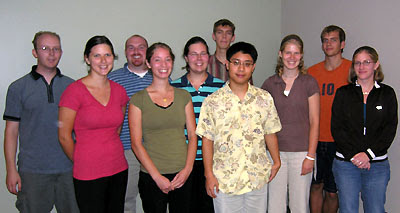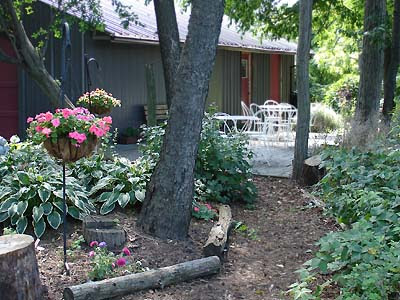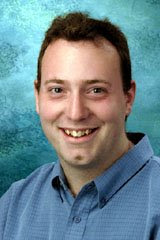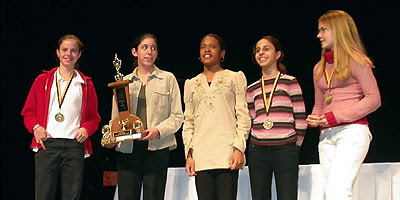
(left to right): Jeremy Burns, Leanne Kersbergen, Matthew West, Amy Koopmans, Laura Brunsting, Timothy Ubbens, Chris Kim [McMaster], Julie Kikkert, James Harskamp and Loretta Vanderspek.
Jeremy Burns, pursued summer research co-supervised with Dr. G. Chiang with funding from the Canada Summer Jobs program and Dr. M.J. O'Donnell at McMaster University. Jeremy worked both at Redeemer and McMaster, carrying out studies on a visceral muscle in the blood-feeding insect Rhodnius prolixus.
Leanne Kersbergen '07, who graduated with a double major in biology and psychology, studied how readily selenium moved from root to shoot tissue of wheat and canola, under the supervision of Dr. Berkelaar. She also studied to what degree this process is influenced by transpiration - the evaporation of water from plant leaves.
Matthew West '07, who graduated with a major in mathematics as well as a major in computer science and physics, worked on NSERC-funded physics research "Time Evolution of Quantum Systems" under the supervision of Dr. van Dijk.
Amy Koopmans, a fourth-year biology major, exposed wheat and canola seedlings to different amounts of thallium and potassium in an effort to determine if potassium and thallium compete with one another for uptake and to see if the two plant species behave similarly or not. Amy worked under the supervision of Dr. Berkelaar.
Professor Jennifer Chiang together with student worker
Laura Brunsting and volunteer Vanessa Chiang '05 served as leaders for an amazing week of scientific discovery. Ten young people, ages 9-12 years, attended Redeemer's very first summer science camp. For one week, these young people explored the world of forensic science through hands-on activities in which they were given the task of solving a "crime" of the day. The campers were guided through a variety of techniques such as how to take and lift fingerprints, identify blood types, analyze lipstick through chromatography, identify insects and more. It is hoped that the camp will be offered in the summer of 2008.
Timothy Ubbens, a second year computer science and mathematics major worked for Dr. Schuurman on an NSERC-funded project "Computer Vision for Mobile Robots."
Julie Kikkert, a fifth year honours biology student, oversaw a study of wheat and canola plants grown in soils contaminated with trace amounts of selenium and thallium, in an effort to see how much of these elements were accumulated by various plant tissues over the course of the life cycle of a plant. Over 1000 plant samples (roots, shoots and seeds) were generated in this study, supervised by Dr. Berkelaar. The samples will need to be analyzed for trace elements next summer.
James Harskamp, now in his third year of an honours biology degree, developed a cadmium microelectrode with help from Dr. Brouwer and Dr. O'Donnell at McMaster. With Dr. Berkelaar, he used this to determine where along the length of a root plants accumulate cadmium and to what extent the rhizosphere (the region immediately surrounding the root) becomes depleted of cadmium as the plant removes it from its exposure solution.
Loretta Vanderspek '07, who graduated with a major in mathematics, explored "Elementary Symmetric Functions and Inertia," a project in qualitative system analysis, funded by NSERC, and under the supervision of Dr. Vander Meulen.
 The Whaley Teaching Garden, which Professor Chiang manages year-round, plays a significant role in the elementary school trips. It is used for demonstrations and hands-on learning as the students are invited to dig up the soil, collect insects and worms, and examine the plants.
The Whaley Teaching Garden, which Professor Chiang manages year-round, plays a significant role in the elementary school trips. It is used for demonstrations and hands-on learning as the students are invited to dig up the soil, collect insects and worms, and examine the plants.





 National Geographic has made finding the Gospel of Judas its top story of 2006. It beat out such Science stories as August's demotion of Pluto to just being one of 40 dwarf planets and February's discovery of a "Lost World" in Indonesia with its previously unknown species of kangaroos, birds and bugs.
National Geographic has made finding the Gospel of Judas its top story of 2006. It beat out such Science stories as August's demotion of Pluto to just being one of 40 dwarf planets and February's discovery of a "Lost World" in Indonesia with its previously unknown species of kangaroos, birds and bugs. The Sciences Division will be hosting its seventh biennial Ontario Christian Schools Science Fair for Grades 7 and 8 at the Redeemer University campus on Thursday and Friday, April 12 and 13. Dr. Humphreys will be presenting his well-loved show, which is open to the public, on the Thursday evening.
The Sciences Division will be hosting its seventh biennial Ontario Christian Schools Science Fair for Grades 7 and 8 at the Redeemer University campus on Thursday and Friday, April 12 and 13. Dr. Humphreys will be presenting his well-loved show, which is open to the public, on the Thursday evening.